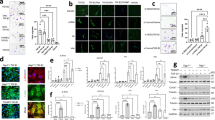Abstract
mTOR, the target of rapamycin, has been promoted as a potential target for cancers, transplantations and even lung fibrosis. However, paradoxically, targeting mTOR has been reported to result in profibrotic side effects. Some recent publications highlight why this might be.
Similar content being viewed by others
References
Granata S, Santoro G, Masola V, Tomei P, Sallustio F, Pontrelli P, Accetturo M, Antonucci N, Carratù P, Lupo A, Zaza G (2018) In vitro identification of new transcriptomic and miRNomic profiles associated with pulmonary fibrosis induced by high doses everolimus: looking for new Pathogenetic markers and therapeutic targets. Int J Mol Sci 19:pii: E125
Lukey PT, Harrison SA, Yang S, Man Y, Holman BF, Rashidnasab A, Azzopardi G, Grayer M, Simpson JK, Bareille P, Paul L, Woodcock HV, Toshner R, Saunders P, Molyneaux PL, Thielemans K, Wilson FJ, Mercer PF, Chambers RC, Groves AM, Fahy WA, Marshall RP, Maher TM (2019) A randomised, placebo-controlled study of omipalisib (PI3K/mTOR) in idiopathic pulmonary fibrosis. Eur Respir J 53(3) pii: 1801992
Malouf MA, Hopkins P, Snell G, Glanville AR (2011) Everolimus in IPF study investigators. An investigator-driven study of everolimus in surgical lung biopsy confirmed idiopathic pulmonary fibrosis. Respirology 16(5):776–783
Tomei P, Masola V, Granata S, Bellin G, Carratù P, Ficial M, Ventura VA, Onisto M, Resta O, Gambaro G et al (2016) Everolimus-induced epithelial to mesenchymal transition (EMT) in bronchial/pulmonary cells: when the dosage does matter in transplantation. J Nephrol 29:881–891
Woodcock HV, Eley JD, Guillotin D, Platé M, Nanthakumar CB, Martufi M, Peace S, Joberty G, Poeckel D, Good RB, Taylor AR, Zinn N, Redding M, Forty EJ, Hynds RE, Swanton C, Karsdal M, Maher TM, Bergamini G, Marshall RP, Blanchard AD, Mercer PF, Chambers RC (2019) The mTORC1/4E-BP1 axis represents a critical signaling node during fibrogenesis. Nat Commun 10:6
Author information
Authors and Affiliations
Corresponding author
Additional information
Publisher’s note
Springer Nature remains neutral with regard to jurisdictional claims in published maps and institutional affiliations.
Rights and permissions
About this article
Cite this article
Leask, A. Do drugs that target mTOR generate CCN2-mediated fibrogenic side effects?. J. Cell Commun. Signal. 13, 277–278 (2019). https://doi.org/10.1007/s12079-019-00520-y
Received:
Accepted:
Published:
Issue Date:
DOI: https://doi.org/10.1007/s12079-019-00520-y




